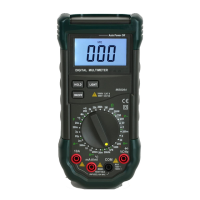3. Connect the test leads to the circuit being measured
4. Read the displayed value. The polarity of red test lead connection will be indicated when making a
DCV measurement.
NOTE:
( Unstable display may occur especially at DC200mV and AC2V ranges, even though you do not put test
leads into input terminals, in this case, if an erroneous reading is suspected, short the V terminal and the
COM terminal, and make sure the zero display.
3.2.2 Resistance measurement
To
avoid electrical shock and/or damage
to the instrument, disconnect circuit power
and discharge all high-voltage capacitors
before measuring resistance.
Resistance is an opposition to current flow.
The unit of resistance is the ohm ( ( ).
The Meter's resistance ranges are 200.0 ( , 2.000k ( , 20.00k ( , 200.0k ( , 2.000M ( , 20.00M ( and 200.0M ( .
To
measure resistance:
1. Set the rotary switch to proper range.
2. Connect the black and red test leads to the COM and ( terminals respectively.
3. Connect the test leads to the circuit being measured and read the displayed value.
Some tips for measuring resistance:
( The measured value of a resistor in a circuit is often different from the resistor's rated value. This is
because the Meter's test current flows through all possible paths between the probe tips.
( In order to ensure the best accuracy in measurement of low resistance, short the test leads before
measurement and memory the test probe resistance in mind. This necessary to subtract for the
resistance of the test leads.
( The resistance function can produce enough voltage to forward-bias silicon diode or transistor junctions,
causing them to conduct.
To
avoid this, do not use the 40M ( range for in-circuit resistance
measurements.
( On 20M ( and 200M ( ranges, the meter may take a few seconds to stabilize reading. This is normal for
high resistance measuring.
( On 200M ( range, the display is approx. 10 digits when test leads are shorted. These 10 digits have to be
subtracted from measuring results. For example, when measuring 100 M ( resistance, the reading will be
101.0 and the correct measuring result should be 101.0-1.0=100.0 M ( .
( When the input is not connected, i.e. at open circuit, the figure "1" will be displayed for the overrange
condition.
3.2.3 Diode
Test
To
avoid electrical shock and/or damage to
the instrument, disconnect circuit power
and discharge all high-voltage capacitors
before testing diodes.

